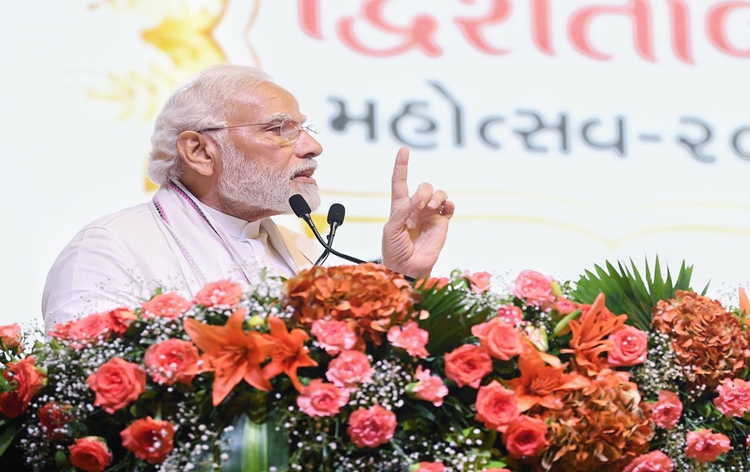Prime minister Narendra Modi praised the journalists and said that during COVID 19, they worked like ‘Karmayogis’. He was speaking at the bi-centenary celebration of Mumbai Samachar Newspaper, Oldest newspaper of Asia, in Mumbai yesterday.
While appreciating the Media Mr. Modi said, During last few years media has published many positive news which helped to create positive environment in country. India always respected wise criticism. He asked media to spread positive words along with Criticism and appealed media to bring forward more positive news when country is celebrating 75years of Independence.
Praising Mumbai samachar for creating awareness among the citizens, he asked the publishers to bring out books in various languages documenting various historical events.
Prime Minister also released commemorative postal stamp of Mumbai Samachar. Maharashtra’s Governor Bhagat singh Koshyari, Chief Minister Uddhav Thackeray, Union Minister Devusinh Chauhan, Leader of opposition Devendra Fadnavis and other dignitaries were present on the occasion.
Prime Minister Narendra Modi said that the Mumbai’s Raj Bhavan is akin to the culture of Maharashtra which manifests courage, dedication, spirituality and the freedom fight.
The Prime Minister said this after inaugurating the ‘Kranti Gatha’ a newly created Gallery of Indian Revolutionaries inside the underground British – era bunker at Raj Bhavan Mumbai and Jal Bhushan, the new residence and office of Governor of Maharashtra.
The PM said, the new residence of the Governor will give new energy to the governance of Maharashtra. He said, as said by Governor Koshyari, the Raj Bhavan will work as a Lok Bhavan and will serve to give a ray of hope for the people of the state.
The Prime Minister said, Raj Bhavan has seen the downfall of the colonial rule and the hoisting of tricolor with pride. The revolutionaries who have got a place in the gallery of revolutionaries will further strengthen the patriotic values.
Maharashtra has inspired the country in various fields. Talking about social reform; from Sant Tukaram to Babasaheb Ambedkar there is a prosperous heritage of social reformers.
He said, by seeing the expansion of sea from the Darbar Hall, we fondly remember the valour of Veer Savarkar.
Citing the example of Ghadar Party, the Prime Minister said, it was national from heart but had a global scale. He added, that the India’s freedom struggle inspired other country’s to fight for their freedom struggle in the world.
He said, Shyamji Krishna Varma’s India House in London was a place frequented by Indians and had become a place of pilgrimage for the freedom fighters in London. He said, Shyamji Krishna Varma died in the year 1930. The PM said, the late leader had made a wish that his ashes be immersed in India when the country gets independence.
Mr. Modi informed that the ashes could have been brough back on the second day when the country got independence way back in 1947. However it took 73 long years, adding that he was fortunate enough to bring ashes back in 2003 from London and immersed at his birthplace in Gujarat.
AIR correspondent reports, The Gallery of Indian Revolutionaries has been created in the bunker that was discovered below Raj Bhavan in 2016. It is a tribute to the known and unknown revolutionaries of the Indian freedom movement. The Gallery of Revolutionaries has been created under the guidance of historian and writer Dr Vikram Sampath with assistance from the South Central Zonal Cultural Centre, Nagpur.
It is being dedicated in the year when India is celebrating Azadi Ka Amrit Mahotsav.
The ‘Kranti Gatha’ gallery also commemorates many revolutionaries from Maharashtra from the First War of Independence in 1857 to the Naval uprising in Mumbai in 1946.
In this Vasudev Balwant Phadke, Chaphekar brothers, Lokmanya Bal Gangadhar Tilak, Veer Savarkar, Babarao Savarkar, Krantiguru Lahuji Salve, Anant Laxman Kanhere, Rajguru, Madam Bhikaji Cama feature prominently.
The story of the armed struggle against the British rule from Maharashtra – then part of the Bombay State – is shown here through sculptures, rare photographs and murals.
The bunker at Raj Bhavan was discovered in 2016 by the then Governor of Maharashtra N Vidyasagar Rao. Built before the First World War, it was used by the British store arms and ammunition.
The bunker has 13 rooms of various sizes and the different cells in it were known as ‘Shell Store’, ‘Gun Shell’, Cartridge Store, Shell Lift, Central Artillery Room, Workshop etc.
A virtual reality museum was inaugurated in this bunker by President Ramnath Kovind on 18 August 2019. However, many rooms in the 13-room bunker were empty. Many of these rooms as well as the wall in the hallway have now been used for the ‘Kranti Gatha – Gallery of Revolutionaries’.


Comment here